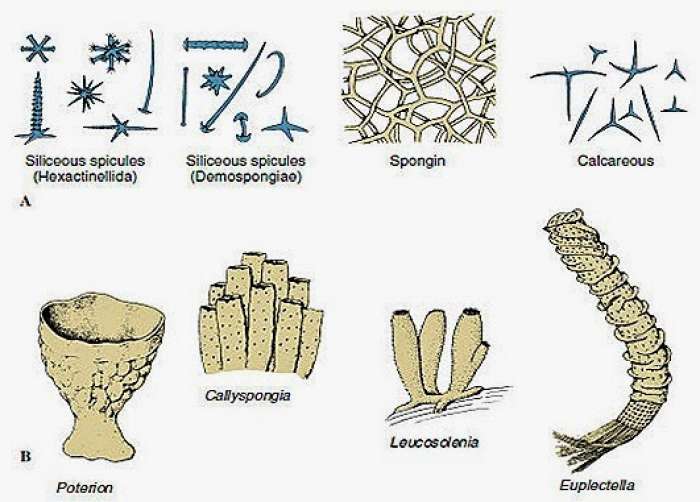Medically reviewed and approved by a board-certified member
Zoology
CLASSIFICATION OF PHYLUM PORIFERA
By BS MediaTwitter Profile | Published: Sunday, 16 April 2017

Phylum porifera is classified mainly basing on skeleton. It is divided into 3 classes. sponges spicules plays a very important role in classification of porifera.
- Class: Calcarea
- Class: Hexactinellida
- Class: Demospongiae
CLASS I : CALCAREA:
- Skeleton is made by calcareaous spicules.
- They show single spongocoel cavity which opens to the outside through a single opening called osculum.
- Radially symmetrical animals.
- Choanocyte cells are large.
This is divided into 2 orders.
Order 1 : Homocoela:
1. Spongocoel is lined by choanocytes internally.
2. Simple sponges or included in this order.
Ex: Clathrina, Leucosolenia, Olynthus.
Order 2 : Heterocoela
1.Spongocoel is lined by epithelial cells.
2.Choanocytes restricted to radial canals only.
3. Leuconoid or Syconoid canal system is seen.
Ex: Sycon, Grantia.
CLASS II : HEXACTINELLIDA (OR) HYALOSPONGIAE:
- Skeleton contains six rayed, or triaxon, siliceous spicules.
- Radially symmetrical.
- These are also known as glass sponges.
This class includes 2 orders
Order 1. Hexasterophora :
1. The spicules are of hexasters type.
2. They are attached to hard objects.
Ex: Euplectella
Order 2. Amphidiscophora :
1. The spicules are amphidiscs.
2. These sponges are attached to the substratum by root tufts.
Ex: Hyalonema, Glass rope sponge
CLASS III : DEMOSPONGIAE:
- Skeleton either absent or present.
- The skeleton contains spongin fibres or silicious spicules or both.
This class is divided into 3 subclasses.
Subclass 1. Tetractinellida:
- The skeleton consists of tetraxon spicules or without spicules.
- They are mostly solid rounded structures.
- Leuconoid canal system is present. This subclass is divided into three orders.
Order 1. Myxospongida:
1.Structure is simple
2.Skeleton is absent.
Eg. Oscarella
Order 2. Carnosa (or) Homosclerophora:
1. Equal sized spicules are present.
2. Megascleres and microscleres are not sharply differentiated.
Ex: Plakina.
Order 3. Choristida:
1. Microscleres and megascleres are distinct.
Eg. Tetilla, Geodia.
Subclass 2. Monaxonida:
- Skeleton consists of monaxon spicules.
- Spongin fibres may or may not be present.
- They are cosmopolitan in their distribution.
- Shallow or deep water forms. This subclass includes 3 orders.
Order 1. Hadromerida:
Spongin fibres absent.Monaxon spicules are represented by tylostyles.
Eg. Cliona (Boring sponge), Tethya.
Order 2. Halichondrida:
Monaxon spicules are seen.
Eg. Halichondria.
Order 3. Poecilosclerida:
Monaxon spicules are present. Microscleres are sigmas, toxas etc.
Eg. Microciona.
End of the article